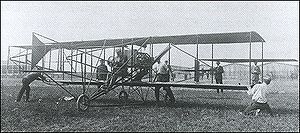- Curtiss No. 1
-
No. 1 / Gold Bug / Golden Flyer Role Early experimental aircraft Manufacturer Herring-Curtiss Company Designer Glenn Curtiss First flight 1909 Retired 1909 Number built 1 The Curtiss No. 1 also known as the Curtiss Gold Bug or Curtiss Golden Flyer was a 1900s American early experimental aircraft, the first independent aircraft designed and built by Glenn Curtiss.
Development
After the success of designing aircraft for the Aerial Experiment Association, Glenn Curtiss formed his own company the Herring-Curtiss Company in March 1909 in association with Augustus Herring. Earlier in the same month the Aeronautical Society of New York had placed an ordered from Curtiss for a new aircraft. The Curtiss No. 1 was the first aircraft both designed and built by Curtiss. Curtiss flew the aircraft to win the Scientific American trophy (which he had won before in the AEA June Bug that he had designed. Encouraged by the success, Curtiss entered the aircraft into the first international air show to be held at Reims in France in August 1909. Before the international competition the aircraft crashed and was badly damaged; Curtiss decided not to rebuild the aircraft and built a new aircraft the Curtiss Reims Racer for the competition.
Specifications
Data from The Pictorial History of American Aircraft
General characteristics
- Crew: One
- Length: 33 ft 6 in (10.2 m)
- Wingspan: 28 ft 9 in (8.8 m)
- Gross weight: 550 lb (250 kg)
- Powerplant: 1 × 4-Cylinder Curtiss engine, 25 hp (19 kW)
Performance
- Cruise speed: 54 mph ( km/h)
See also
References
- Aero-web
- Centennial of Flight
- The Illustrated Encyclopedia of Aircraft (Part Work 1982-1985), 1985Orbis Publishing
Aircraft produced by Curtiss and Curtiss-Wright Manufacturer
designationsNo. 1 • No. 2
Model letters: C • D • E • F • G • GS • H • J • K • L • M • N • PN • JN • R • S
Model numbers: 1 • 2 • 3 • 4 • 5 • 6 • 7 • 8 • 9 • 10 • 11 • 12 • 13 • 14 • 16 • 17 • 18 • 19 • 20 • 21 • 23 • 24 • 26 • 28 • 31 • 32 • 33 • 34 • 35 • 36 • 37 • 38 • 39 • 40 • 41 • 42 • 43 • 44 • 47 • 48 • 49 • 50 • 51 • 52 • 53 • 54 • 55 • 56 • 57 • 58 • 59A/59B • 60 • 61 • 62 • 63 • 64 • 66 • 67 • 68 • 69 • 70 • 71 • 72 • 73 • 75 • 76 • 77 • 79 • 81 • 82 • 84 • 85 • 86 • 87 • 88 • 90 • 91 • 94 • 95 • 96 • 97 • 98 •
"CW" models: CW-1 • CW-2 • CW-3 • CW-4 • CW-5 • CW-6 • CW-7 • CW-8 • CW-9 • CW-10 • CW-11 • CW-12 • CW-14 • CW-15 • CW-16 • CW-17 • CW-18 • CW-19 • CW-20 • CW-21 • CW-22 • CW-23 • CW-24 • CW-25 • CW-27 • CW-29 • CW-32
By role Experimental: No. 1 • Model C • Tanager
Racing: No. 2 • CR • R2C • R3C
General utility: Model D • Model E • Model F • Robin • Thrush
Maritime patrol: Model H • HS-1L and -2L
Training: Model L • Model JN • Fledgling • AT-4 Hawk • AT-5 Hawk
Fighters: 18 • PW-8 • P-1 • P-2 • P-3 • P-4 • P-5 • P-6 • XP-31 • P-36 • P-40 • XP-46 • XP-53 • YP-60 • XP-62 • XP-71 • XP-87
Naval Fighters: HA • FC • F2C • F3C • F4C • F6C • F7C • F8C • F9C • F10C • F11C • XF12C • F13C • XF14C • XF15C
Airliners: Eagle • Condor II • Kingbird
Naval Scouts/Dive Bombers: CS • GS • S2C • XS3C • S4C • SC • SBC • SB2C • XSB3C • SOC • SO2C • SO3C
Observation: O-1 • O-12 • O-13 • O-16 • O-18 • O-26 • O-39 • O-40 • O-52
Naval Observation: OC • O2C • O3C
Naval Bombers: 24 • BFC • BF2C • XBTC • XBT2C
Ground Attack: A-3 • A-4 • A-5 • A-6 • A-8 • YA-10 • A-12 • YA-14 • A-25 • A-40 • XA-43
Licensed production: NBS-1
Lists relating to aviation General Aircraft (manufacturers) · Aircraft engines (manufacturers) · Airlines (defunct) · Airports · Civil authorities · Museums · Registration prefixes · Rotorcraft (manufacturers) · TimelineMilitary Accidents/incidents Records Categories:- United States experimental aircraft 1900–1909
- Curtiss aircraft
- Single-engined pusher aircraft
Wikimedia Foundation. 2010.

